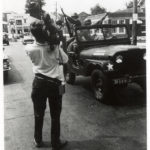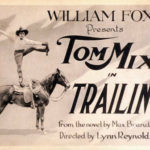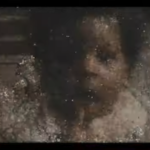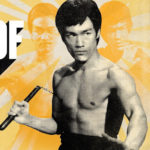The Task and Art of Restoring Sound on “Ornette”
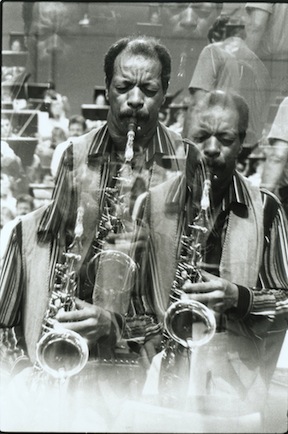
“Ornette: Made in America.” Milestone Film
A project like the restoration of Shirley Clarke’s portrait of jazz iconoclast Ornette Coleman – her 1986 film Ornette: Made in America — can hardly succeed if its visual appeal is not matched by sparkling audio. (See article from 23 February 2015.)
Clarke filmed the alto-sax great over three decades and also recreated scenes from his boyhood in Fort Worth, Texas.
She captured Coleman on and off stage in New York city, Nigeria, and Morocco. She concluded her recording at a 1983 homecoming tribute concert in Fort Worth that featured Coleman’s “Skies of America” suite where the saxophonist’s Prime Time band performed with John Giordano conducting the Fort Worth Symphony Orchestra.
Clarke’s film responded stylistically to Coleman’s idiosyncratic approach. With small combos and then larger ones, he freed his band members from jazz’s traditional insistence on structured meter, harmonics, and chord progression and left band members largely to their own devices.
Milestone Film, in a collaboration with UCLA Film & TV Archive, entrusted oversight of the project to one of the most respected figures in preservation, Ross Lipman who, hired out sound restoration to John Polito, the owner and chief engineer of Burbank-based Audio Mechanics, which has recently won a contract from 20th Century Fox to supervise the digital preservation of sound on all its inventory.
Polito’s capabilities are suggested by the range of his projects — in addition to musical restoration, which is the vast bulk of Audio Mechanics’ work, he has assisted the FBI and served as an expert witness. His credits include both the OJ Simpson and Kobe Bryant trials.
For the Ornette project,Polito worked with a new 35mm composite print made from Clarke’s original, edited, 35mm negative, which incorporatedelements from various archival sources as well as Super-16mm original footage taken by Shirley Clarke and her cameraman, Ed Lachman (who later was the cinematographer for Erin Brockovich, 2000, The Virgin Suicides, 1999, and Far from Heaven, 2002).
Polito managed to make the restored sound of Ornette sharp, clear, and vibrant, as befits a portrait of one of the most prominent of all jazz innovators. Polito says his biggest challenge was to bring out the clarity of the live music performances. He and Ross Lipman, the supervisor for the restoration, spent a lot of time fussing over the equalization and noise reduction settings to optimize those, he says.
John Polito says:
I’m a musician and I like to play jazz so working on Ornette was not just an interesting project audio-wise; I have a passion for music, so I was mega-interested in it. His very experimental style of music was just intriguing to me.
On all my projects obviously I always want the best fidelity, but this one, what I recall is optical distortion.
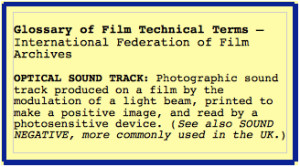 It was in average condition. The thing I remember being bothered by was the distortion. You’re always going to get some distortion with optical tracks. Some are better than others. There are certain frequencies that tend to have that characteristic optical-distortion sound. This had it.
It was in average condition. The thing I remember being bothered by was the distortion. You’re always going to get some distortion with optical tracks. Some are better than others. There are certain frequencies that tend to have that characteristic optical-distortion sound. This had it.
There are no tools in the current suite of audio-restoration or post-production tools that are geared specifically for distortion. There are tools that if you work with them a lot you come across happy accidents: ways to deal with certain types of distortion.So I spent a lot of time working on that — I guess you could say, to try to mask the distortion, more than anything.
In the sections of music with the orchestra, I remember that having a bit too much of a roomy feel, and not a lot of definition. So I worked on that a lot.
Just how much is “a lot,” and what does that consist of?
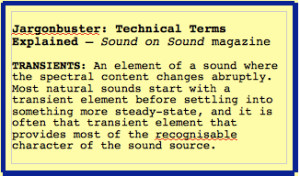 The standard audio work flow is first you get it all in synch with picture, and then for optical sources, you might run some sort of automatic de-click or de-crackle pass and you have to calibrate it so it’s not going to interfere with the music. A lot of times they will attack transients of especially instruments and drums and percussion, and oftentimes voices, like male voices that have a lot of rich character to them… So you have to calibrate that so you don’t harm those. And then you have to get out all the extra pops and clicks that are missed, and that takes a long time.
The standard audio work flow is first you get it all in synch with picture, and then for optical sources, you might run some sort of automatic de-click or de-crackle pass and you have to calibrate it so it’s not going to interfere with the music. A lot of times they will attack transients of especially instruments and drums and percussion, and oftentimes voices, like male voices that have a lot of rich character to them… So you have to calibrate that so you don’t harm those. And then you have to get out all the extra pops and clicks that are missed, and that takes a long time.
It’s working on fine tuning the settings for masking the distortion. In those cases, you’re not looking at a frame-by-frame scenario like when you’re taking pops and clicks out — that’s a frame-by-frame scenario that takes a lot of time. But this is more like, OK, this section of music has this type of distortion, and rather than just say, OK, ‘I EQ’d it and it sounds nice,’ it’s really trying a lot of experimentation to try to minimize that distortion.
How big a factor was your interest in jazz?
This project involved a bit of a personal desire to make it better, but I tend to do that with everything. I always like a challenge, and every project has its own unique something-or-other, some unique challenge that inspires me to tackle it. In this case, that was wanting to make the music, which is the focus of the film, sound as good as it could, with the source we had. But there were still sections where I wasn’t 100 percent satisfied.
And “a lot” is… tens of hours? Hundreds of hours?
This project took about 55 hours of work. Generally speaking, I’ll spend anywhere from two days to two weeks, that’s the average range. There are projects that have taken two months, but that is the range… In this case, the film was 77 minutes long, just under average film length.
How do you prevent yourself not stopping?
Sometimes budgets will dictate how picky you can be as far as the little pops and clicks and blemishes. I do always try to be conscious of that. If there’s a budget and it’s more work than the budget will allow, you say, ‘Well, this is what you’ll get for the budget you have.’
What’s your thinking about how “good” to make old film sound?
That’s always such an interesting question. When it comes to sound on film, you also have to consider the playback environments of the day. Obviously in the ’30s and early ’40s the amplifiers were not as strong; the speakers were not as wide fidelity; the screens were not as transparent. But they were mixing in those environments, and obviously were trying to make it sound as good and flat as they could with the equipment that they had.
So, when you take that sound, and now you put it on a modern system, it really does not sound the way they intended it to sound, and so you have to know that aesthetic that they were going for.
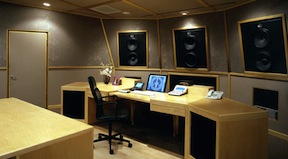 I was fortunate that I had a lot of input early in my career and a sort of aesthetic stewardship from Bob Gitt at UCLA. He was one of my early clients and one of the first people to be involved in film preservation and restoration, and had done a lot of projects. I didn’t know what it should sound like, but he did.
I was fortunate that I had a lot of input early in my career and a sort of aesthetic stewardship from Bob Gitt at UCLA. He was one of my early clients and one of the first people to be involved in film preservation and restoration, and had done a lot of projects. I didn’t know what it should sound like, but he did.
I feel like I’ve really had that imparted on me. He would explain about things like the old playback systems. He was a really good teacher. And when he said, ‘That’s how that should sound,’ I’d really lock that into my head.
— Peter Monaghan
Previous Post: Shirley Clarke Makes the Connection with Jason & Ornette
Next Post: Songs from Over the Top

